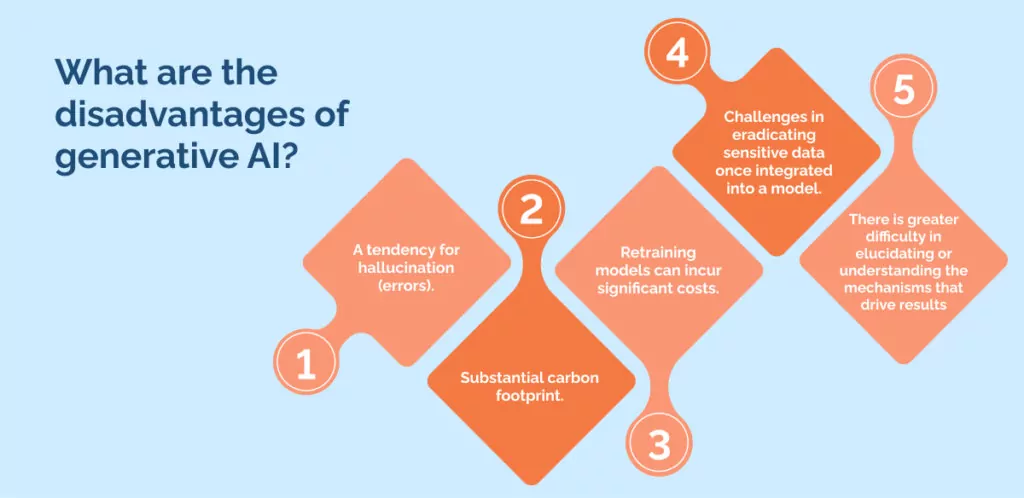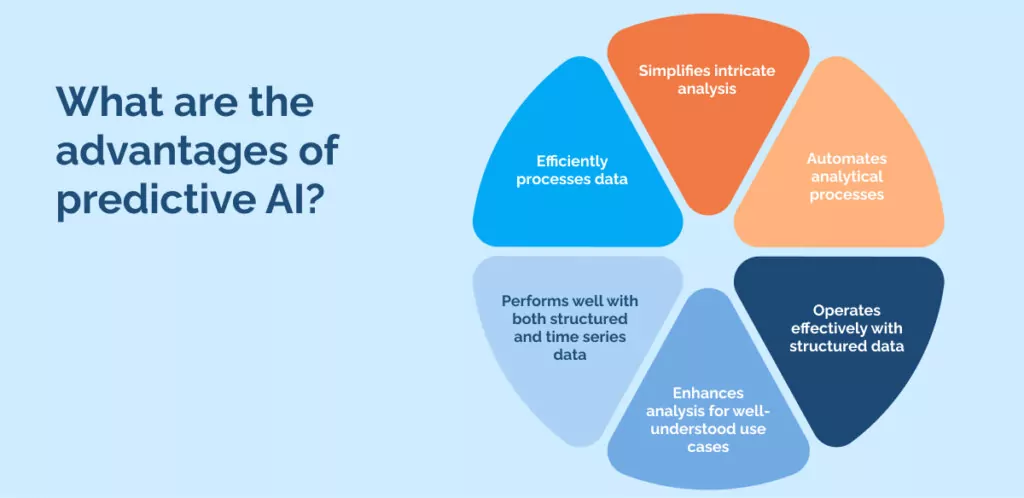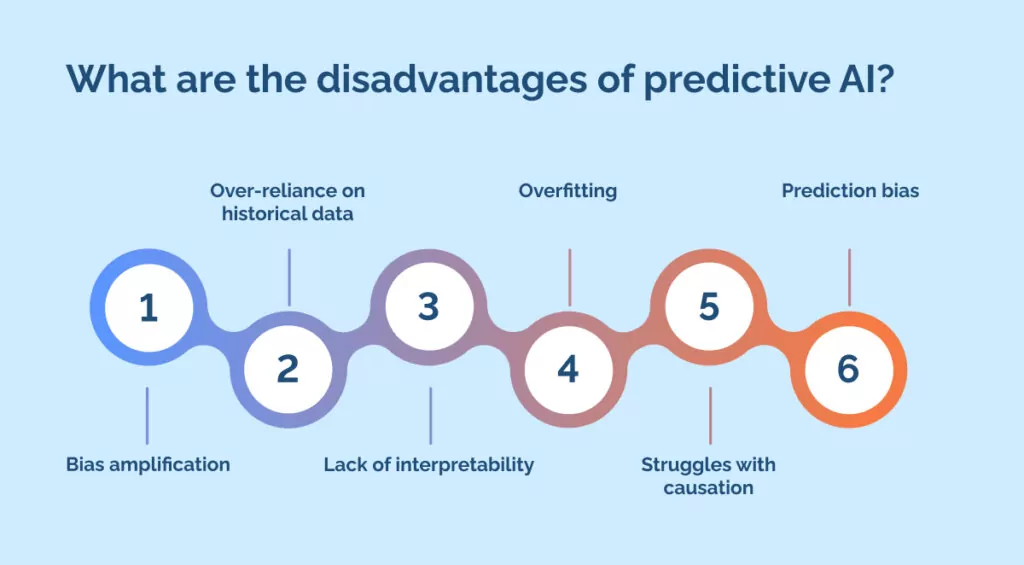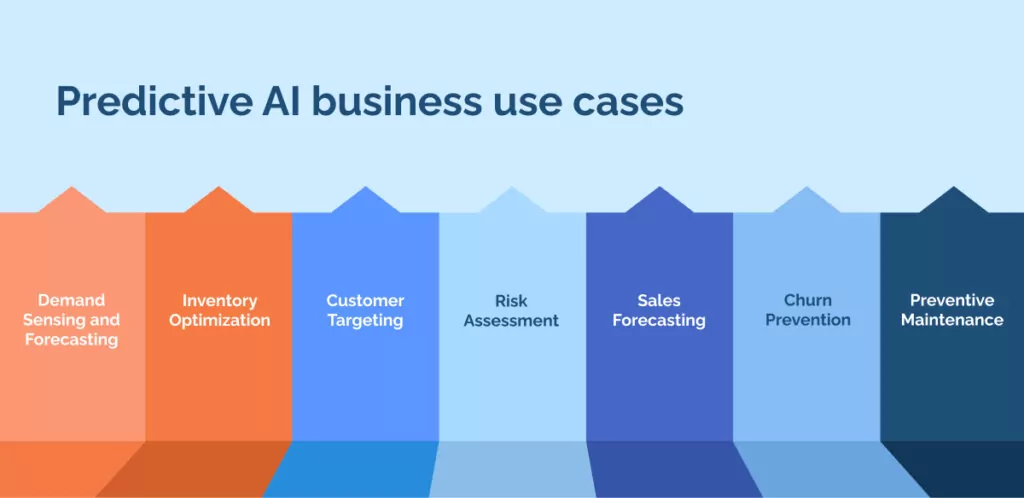
It’s clear generative AI is here to stay, but what’s the difference between all the types?
Generative and predictive AI are the two main types of AI used in business, so it is helpful to know them before investing in your use cases.
By comparing generative AI vs predictive AI, you can ensure your investment into AI tools is correct for your organization and get that ROI quickly and fuss-free as you consider how AI will change the future of work for your enterprise.
Generative AI is the most successfully adopted service, with ChatGPT gaining one million users in its first week.
The main difference between generative and predictive AI is that generative AI generates large amounts of text using large language data models. Predictive AI, while using similar methods, produces the outcome of predictions, not content.
However, these differences’ details are essential for a successful organization.
To help you understand the differences between generative AI vs. predictive AI, we will answer the following questions:
- What are the key differences between predictive AI and generative AI?
- What is generative AI and how does it work?
- What are the advantages of generative AI?
- What are the disadvantages of generative AI?
- What are some potential business use cases for generative AI?
- What is predictive AI and how does it work?
- What are the advantages of predictive AI?
- What are the disadvantages of predictive AI?
- What are some potential business use cases for predictive AI?
What are the key differences between predictive AI and generative AI?
There are three main differences between generative AI vs. predictive AI models. Knowing these differences can help you decide which you may need for different applications in your enterprise.
Creativity: Generative AI displays creativity, generating entities that have never existed before. Predictive AI lacks the capacity for content creation as it focuses on the likelihood of future events.
Inferring the future: Predictive AI employs historical and current data to identify patterns and project potential future outcomes. Generative AI also recognizes patterns but amalgamates them into distinctive new forms.
Different algorithms: Generative AI employs intricate algorithms and deep learning to create new content based on its training data. Predictive AI typically depends on statistical algorithms and machine learning to analyze data and formulate predictions.
What is generative AI and how does it work?
Generative AI is a form of artificial intelligence that can generate diverse content, such as text, imagery, audio, video, and synthetic data, using machine learning algorithms and training data.
Generative AI models aren’t entirely novel; they began in the ’60s with chatbots.
In 2014, generative adversarial networks (GANs), a subset of NLP (natural language processing) machine learning, empowered generative AI to craft truly authentic images, videos, and audio with real people.
Generative AI utilizes large language models, learning from extensive existing data sets to create content through recurrent neural networks.
Upon user interaction, the tool employs the large language model to address prompts, be they text, realistic images, video, design, or musical notes processed by the AI system.
Diverse algorithms create content, including essays, problem solutions, or imaginative outputs from images or audio.
Users can refine outcomes after the initial response, offering feedback on style, tone, and other desired elements in the generated content.
What are the advantages of generative AI?

Generative AI presents many advantages, foremost among them being a significant reduction in human risk and error.
- Automates the generation of code and various elements in software development.
- Generative AI creates new content with user inputs.
- Condenses intricate documents or datasets.
- Effectively handles unstructured data.
- Produces straightforward responses to intricate queries.
- Demonstrates proficiency across diverse modalities, including text, video, audio, robot instructions, and data formats.
The advantages of generative AI helped make it so popular so quickly. However, it also has disadvantages.
What are the disadvantages of generative AI?

Like most digital tools, generative AI is not perfect. Consider the disadvantages below before investing in this tool for your organization.
- A tendency for hallucination (errors).
- Substantial carbon footprint.
- Retraining models can incur significant costs.
- Challenges in eradicating sensitive data once integrated into a model.
- There is greater difficulty in elucidating or understanding the mechanisms that drive results, especially if staff are using shadow AI practices.
Take time to understand these disadvantages before deciding whether generative or predictive AI suits your needs.
Generative AI business use cases
It’s challenging to imagine using generative AI without considering use cases.
Common business applications of generative AI encompass:
- Code generation.
- Creation of marketing materials.
- Searching through multiple manuals.
- Tailoring content for customers and employees.
- Adapting learning experiences.
- Translating data across various formats.
- Providing customized explanations for diverse expertise levels or roles.
- Localizing content for different geographies and languages.
- Researching complex topics.
- Condensing and summarizing risks across various domains in risk management.
- Summarizing resumes to streamline candidate selection.
- Managing skill taxonomies in learning and development.
- Combining ChatGPT and CRM for better customer experience.
- Summarizing patterns in call center interactions.
- Simplifying intricate UIs into simple text prompts.
Ask yourself if these use cases apply to your organization to establish if generative AI is right for you.
What is predictive AI, and how does it work?
Predictive AI technology finds applications in predicting financial market trends, scheduling equipment maintenance, and detecting anomalies.
It delivers substantial value across various business realms, including fraud detection, preventive maintenance, recommendation systems, churn prediction, capacity management, and logistics optimization.
Predictive AI employs a range of ML and AI algorithms distinct from those utilized in generative AI, including:
- Neural networks for diverse tasks.
- Linear regression for identifying correlations.
- Logistic regression for data classification.
- Support vector machines for data classification.
- Decision trees for outcome estimation.
- Random forests for data classification.
- K-means clustering for grouping data.
- Self-trained naive Bayes classifier for data classification.
Consider these points to understand how predictive AI aims differ from those of generative AI and to enable you to optimize its use.
What are the advantages of predictive AI?

Predictive AI has many advantages, especially in how predictive analytics can help direct the user to act on likely future events.
The advantages of predictive AI encompass:
- Efficiently processes data.
- Simplifies intricate analysis.
- Automates analytical processes.
- Operates effectively with structured data.
- Enhances analysis for well-understood use cases.
- Performs well with both structured and time series data.
Knowing the advantages of predictive AI applications is essential to ensure your organization’s needs fit the tool’s strengths.
What are the disadvantages of predictive AI?

Understanding and addressing these limitations is crucial for businesses to shield themselves from pitfalls.
Often, this entails integrating predictive AI with other analytics techniques to mitigate inherent weaknesses of using AI in the workplace.
Several limitations are associated with predictive AI, including the list below.
Bias amplification
Amplification of bias in underlying data leads to inconsistencies in interpretation and ethical concerns, making it one of the biggest AI risks. Implement rigorous data and model governance practices to minimize these risks.
Over-reliance on historical data
Over-reliance on historical data patterns can lead to augmenting training data with real-time and external data sources and feedback loops to update models with recent information.
Lack of interpretability
The lack of interpretability in complex predictive models, especially those built on deep neural networks, makes transparency and explainability challenging.
Using simpler models can help identify and address issues. Employing explainable AI techniques can aid business leaders in understanding model workings and predictions.
Overfitting
Overfitting, where an AI model closely fits itself to the training data, leading to inaccurate predictions.
Struggles with causation
Struggle with causation, as predictive models excel at identifying correlation but may struggle to distinguish between correlation and causation.
Leveraging causal inference methods and randomized controls to differentiate between the two.
Prediction bias
Prediction bias resulting from excessive training on data and business cases.
Scrutinize the number of cases analyzed for an industry subsegment, recognizing that success in one sector may not necessarily translate to another.
Predictive AI business use cases

To ensure organizations derive maximum value from predictive AI in business, implement best practices, such as establishing clear objectives, defining KPIs, and maintaining data quality.
Regularly monitor results to verify model performance and review model factors to identify outdated elements and potential biases.
Predictive AI finds application in various ways within businesses.
Demand Sensing and Forecasting
Predictive AI uses historical and causal data to create more precise short-term granular demand forecasts, aiding inventory location and allocation decisions.
Inventory Optimization
An analytical approach incorporating predictive AI helps accurately identify and set inventory targets across all locations and types in the supply chain.
Customer Targeting
Analyzing historical data, predictive AI forecasts customers that will probably respond positively to specific offers or promotions.
Risk Assessment
Widely used by financial institutions and lenders, predictive AI evaluates fiscal and credit risks associated with defaults or delinquencies.
Sales Forecasting
Projecting future sales based on historical data, market trends, and external factors helps companies allocate resources, manage demand, plan supply chain operations, and optimize inventory levels.
Churn Prevention
Predictive AI analyzes historical interactions and customer demographic data to predict potential churn, enabling proactive retention efforts.
Preventive Maintenance
Optimizing maintenance schedules to reduce costs while minimizing the risk of failures.
Research carefully before investing in generative or predictive AI
Caution prevails in generative AI and predictive AI investments, so thorough research is imperative to grasp these technologies’ intricacies, benefits, and potential pitfalls.
Organizations must align AI capabilities with their needs, considering real-world applications and ethical implications.
Informed decision-making is key to unlocking the transformative potential of generative and predictive AI while mitigating data privacy and bias risks.
Tristan Ovington
Tristan Ovington is a professional senior writer and journalist, specializing in providing expert insights on various topics such as digital adoption, digital transformation, change management, and Cloud apps. He delivers his knowledge through accessible online content that is data-driven and presented in a friendly tone, making it easy for readers to understand and implement.



